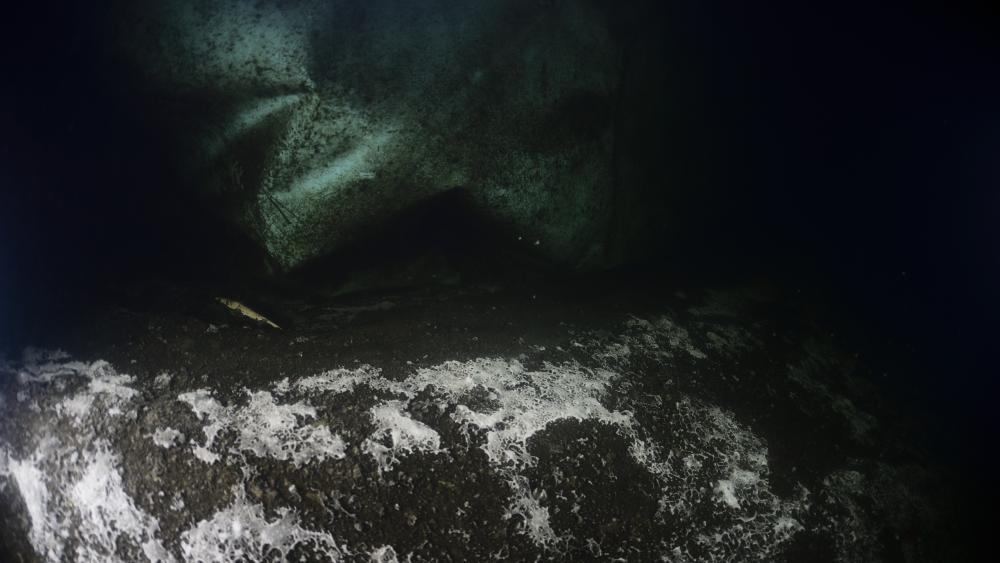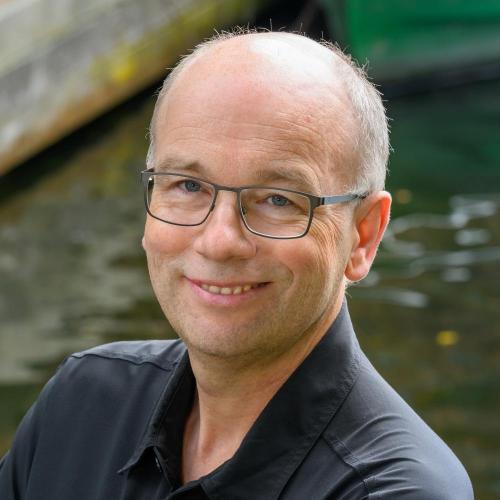
Oxygen is becoming increasingly scarce in the depths of lakes around the world. This has far-reaching effects, including on various metabolic processes at the bottom of the lake. | Photo: Solvin Zankl
Lonely landscapes, sunshine at midnight, rationed drinking water, a gravel road as a motorway: Robert Schwefel still has vivid memories of his research trip to Alaska a few years ago. As part of a joint project with the University of Santa Barbara in California, the physicist, who explores oxygen depletion under ice, studied four lakes in northern Alaska that are covered by ice in winter. “We wanted to know how the oxygen content of the lakes changes under ice. Our results show that ice-covered lakes are also dynamic systems,” stated the researcher. The explanation: The sunlight that penetrates the ice and the heat stored in the sediment keep the water circulating. And these physical processes play a crucial role in determining the oxygen balance.
The second major finding of the study was surprising: oxygen depletion decreases significantly during the winter. “Oxygen depletion is very pronounced in the first 30 days, after which it declines significantly,” explained Robert Schwefel. This is also due to the heat stored in the sediment: it is transferred to the water and drives exchange processes in the deep water, where bacteria consume oxygen. Over time, these exchanges level out.
No evidence of lower greenhouse gas production with less ice
The results suggest that most of the oxygen depletion takes place at the beginning of the ice cover. A shorter duration of the ice cover is therefore largely irrelevant because the consumption processes have already taken place. “We had assumed that the oxygen concentration at the end of the winter would increase significantly with shorter ice cover, but we found no evidence for this effect,” remarked Robert Schwefel. Since greenhouse gases such as carbon dioxide and methane accumulate in anoxic conditions, Arctic lakes may contribute more to greenhouse gas emissions and global warming than previously thought.
Even in our latitudes, lakes are subject to changes that affect their oxygen balance. “In Lake Stechlin, the stratification period has lengthened dramatically in recent years, which means that the oxygen-rich upper layer and the rather oxygen-poor lower layer of the lake mix less frequently and for shorter periods,” stated Hans-Peter Grossart. The mixing periods in autumn and spring are now at least one month shorter. If there is no mixing in autumn, complete mixing does not take place until spring, shortly before the new stratification. The lake then remains stratified for even much longer. As a result, the concentration of dissolved oxygen (DO) in the deep water greatly decreases and oxygen depletion increases. Levels below 3 milligrams of oxygen per litre (mg/l) are referred to as hypoxia, which is critical for fish. Anoxia is the absence of oxygen.
Nutrients are a key element
Deep-water anoxia in one summer can lead to severe anoxia in subsequent summers. A team with the participation of Hans-Peter Grossart analysed data from 656 lakes to identify the mechanisms that need be present simultaneously for this to happen. Nutrient inputs are a key element. They stimulate the growth of algae and bacteria: Dead material sinks and is broken down by bacteria. This microbial activity leads to respiration and oxygen levels drop. “The causes of the global increase in eutrophication are manifold. In addition to agriculture, nitrogen from the atmosphere, which enters the lakes through the air, plays an important role,” explained the biologist. In addition, global air temperatures are rising, which favours more stable and longer stratification phases and further reduces oxygen concentrations.
Another factor is that anoxic zones alter biogeochemical processes in complex ways and intensify internal cycling. This can also reduce the retention capacity for phosphate in the sediment, making more nutrients available for algal growth in the water body. These feedback mechanisms accelerate lake eutrophication. “The sediment in Lake Stechlin also contains relatively high levels of phosphate, and there is a risk that this will be released again due to changes in environmental conditions,” commented Hans-Peter Grossart. The researcher is also concerned about the fact that in lakes with prolonged anoxic periods, hydrogen sulphide can accumulate as a result of sulphate reduction. “It stinks and is toxic, the whole chemistry of the lake changes. This is also a problem for drinking water,” he stated. The competition between phosphate and hydrogen sulphide also explains why the sediments in Lake Stechlin can bind less phosphorus to iron than before.
Similar findings are reported in a study in which also Stella Berger was involved. The study analysed and compared data on dissolved oxygen in the deep water of 12 stratified lakes in the northern hemisphere in winter and summer. “Hypoxia, i.e. dissolved oxygen concentrations below 3 mg/l, occurred in more than half of the lakes and lasted on average 83 per cent longer in summer than in winter,” the researcher reported. How quickly dissolved oxygen decreased depended mainly on the morphology of the lake in winter and on the trophic state in summer. “As long as dimictic lakes mix completely twice a year, the entire water body – right down to the bottom – is supplied with oxygen in autumn and spring. In the wake of climate change, with warmer and longer summers, these patterns are changing and the period of stable stratification is lengthening. This can result in full circulation starting later in the autumn, being incomplete or failing altogether, leaving deep water oxygen levels low. We are seeing the first signs of this in Lake Stechlin,” stated Stella Berger.
Oxygen concentration and methane production closely linked
Mina Bizic wants to know how oxygen in lake water is linked to the production of the greenhouse gas methane: Around 25 per cent of global methane emissions come from lakes, reservoirs and rivers. “Recent measurements show that methane emissions from lakes have already increased,” stated the researcher. For a long time, methane was thought to be produced only under anoxic conditions by a specialised group of microorganisms belonging to the archaea (single-celled organisms with similarities to both bacteria and higher organisms). These microorganisms break down organic material near and in the sediment, producing methane in the process. “However, as we have been able to show, it is also produced – continuously – in other parts of the water, under oxic conditions,” emphasised Mina Bizic. Oxic methane production can account for up to 85 per cent of a lake’s total emissions, but it can also be much lower.
Too many nutrients in the lake also play a role. They often lead to cyanobacteria and algae blooms. When this biomass dies, it is decomposed by microorganisms that need oxygen to do so. This depletes the lake of oxygen and creates more oxygen-free zones in the lake where the archaea can continue their work. In addition, some of this biomass sinks in the form of floc-like aggregates. If these are large enough, they can contain oxygen-free zones, as Mina Bizic stated. “We call these anoxic microniches,” she explained. Archaea can also produce methane in these zones, which is released to the surface and into the air much faster than from the bottom of the lake. The morphology of the lake also plays a role in determining the relationship between the main source of methane and the atmosphere – classic or oxic methane production.
Many trace organic compounds in rivers are harder or impossible to break down without oxygen
Oxygen is also important for the self-purification of water bodies, as Jörg Lewandowski’s work shows. His research group studies the degradation and transformation of organic micropollutants, such as industrial and pharmaceutical residues, in the hyporheic zone. Put simply, this zone is the stream bed. It is where many degradation and transformation processes take place that contribute significantly to the self-purification capacity of flowing waters. Ripple structures, a kind of small dune on the stream sediment, cause some of the river water to flow through the sediment. “Many trace substances are well degraded along this flow path, albeit rarely completely,” stated Jörg Lewandowski. Transformation products are formed. In the absence of oxygen, little degradation takes place. Organic micropollutants are undesirable in river water because they pollute ecosystems, can accumulate in the food chain and limit the usability of water, e.g. for drinking water production.
Oxygen depletion and its consequences can be predicted
In order to better monitor the effects of climate and environmental changes on lakes, Michael Hupfer’s research group, in which Robert Schwefel is a postdoctoral researcher, has co-developed two models. The first can be used to predict the development of oxygen levels in lakes in summer: “It is a highly simplified model that predicts the oxygen constellation as a function of temperature under nutrient-poor, moderately nutrient-rich or nutrient-rich conditions and the duration of stratification,” explained Robert Schwefel. The model is based on extensive oxygen depletion data from a literature review and has been validated using IGB measurements from several lakes.
Together with the TU Bergakademie Freiberg, the team has also developed an easy-to-use calculation method that can be used to estimate the effects of oxygen depletion on the deep water of lakes. The researchers used high-resolution temporal and spatial information on the duration of anoxia. They also showed that this information can be calculated relatively easily from a few measurements and the topography of the lake bed. “Such models can also be used to develop adaptation strategies for the management of lakes and reservoirs,” concluded Michael Hupfer, adding that research can not only contribute to a better understanding of the severity of the situation, but also help to initiate possible improvements.











